Vintage Planes in Eastern Australia, 2005
Part 2: Sydney to Melbourne
 Photos © R.Leeuw
Photos © R.Leeuw(Photos can be enlarged by clicking on them)
 Photos © R.Leeuw
Photos © R.Leeuw
 What better way to see Sydney than from the air in a vintage radial-propelled bushplane!
What better way to see Sydney than from the air in a vintage radial-propelled bushplane!
I took my opportunity for a flightseeing flight from Rose Bay on board this fine vintage DeHavilland DHC-2 Beaver floatplane. Its tailnumber is VH-AQU and construction number is 1544. Mike was our pilot and he flew us over Darling Harbour and along the coastline for a short bit. What we saw can be seen on my travel account of this trip.
This is what Wally Scott sent me in Aug.2007: And John D.Williams wrote me in June 2008: |
|
VH-AAM is seen here on approach into its home base at Rose Bay and soon found its spot on the dock. Construction number of this 1961 vintage bushplane is 1492; its history reads as follows: G-213 for Republic of Ghana Air Force, registered N37772, in 1976 as VH-IMR in Bankstown, Percheron Transport, Aqua-Flite (Cairns,QLD), 20Mar92 flown to Bankstown,NSW after Aqua-Flite ceased operations, VH-AAM registered 13Apr92 for Airag Services (Bankstown,NSW), Nov92 to Australian Barrier Reef Airlines (Cairns,QLD), Seaplane Safaris - Aviant Pty/Ltd on 19Aug03. Source & more photos during its career on www.dhc-2.com |
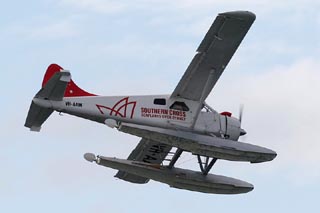
|

|
|
DeHavilland of Canada produced this plane to serve the many small communities in Canada, isolated in the vastness of that country. The same goes for Australia of course. It was hugely successful and almost 1700 were built. The first flight, of a prototype, flew on August 16th, 1947. Production began in 1948 and ran for 2 decades. A few technical bits: the Mark I has a Pratt & Whitney R985 Wasp Junior nine cylinder radial piston engine (450hp) and it has a two blade variable pitch Hamilton Standard prop. The maximum speed is 225km/h (121kt), though normal cruising speed would be 201km/h (109kt). It makes a very nice racket ! Seawing Airways Rose Bay used to be the base for flying boat services to various parts of the world. That era ended in 1974 with the closure of the service to Lord Howe Island. Rose Bay is only a short trip by ferry from Circular Quay. |
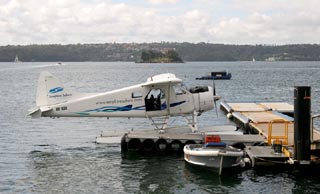 The base of Seaplane Safaris and Southern Cross Seaplanes doesn't get any bigger than this: they share a small office and the dock. Maybe if I had come earlier in the morning (other than at noon), the sun would have been in a better position for photography from the shore.
The base of Seaplane Safaris and Southern Cross Seaplanes doesn't get any bigger than this: they share a small office and the dock. Maybe if I had come earlier in the morning (other than at noon), the sun would have been in a better position for photography from the shore.This is VH-NOO with c/n 1535. Its history reads thus: delivered 19Nov63, registered as VH-IDI for Hawker DeHavilland Australia on 05Feb64, reported at Moorabbin, Melbourne named "Superspread72", for Superior Aviation in 1987, to Leafair of Cheltenham,VIC., changed on Australian Register on 25Feb92 with Tableland Topdressing P/L. of Armidale,NSW, back to Leafair P/L. of Moorabbin,VIC, registered as VH-NOO for Addenbrook Marine Pty. of Pyremont,NSW, Jambren Air Services Pty/Ltd. of Wahroonga,NSW and registered 11Jan02 to Seaplane Safaris. Source and more photos during its career on www.dhc-2.com. |
 The success of the DHC-2 Beaver was in part due to chance...
The success of the DHC-2 Beaver was in part due to chance...Its concept design was created by Wsiewolod Jakimiuk, deHavilland's chief design engineer (1905-1985). He concentrated on a sleek design ("aerodynamics-over-power") and his all-metal plane with a cantilever wing (no struts) was powered by an inline 300hp deHavilland engine that was being developed by DHC in the UK. The detail design was handed over to Fred Buller and Dick Hiscocks; they realized that the "DHC-X" would be underpowered, esspecially on floats. Only because the DHC 300hp engine blew up on the test bench and by insistence of Buller and Hiscocks, the widely available Pratt & Whitney 450hp was selected for what was to become the DHC-2 Beaver. The wing had been modified to maximum aerodynamic design, to fight the shortcomings of the 300hp engine. With the radial engine the fuselage had to be modified to fit its size, but this created also a wider cabin. The struts to the wing were added to strengthen the wing to support the engine. The Beaver had its first flight on 16Aug47; a familiar name in Canadian aviation history, Punch Dickens, appeared on the scene: he had no problem selling this fantastic bushplane for deHavilland. 1631 in total were produced. 60 Turbo Beavers were built and production ended in 1968. |
|
VH-TRN is a Transavia Airtruk (note the spelling) and is here displayed in the Powerhouse Museum in Sydney. The Transavia PL-12 Airtruk (of Transfield,NSW) was designed by Luigi Pellarini and built in Australia; it first flew on15Apr65. It performed tasks such as top dressing and spraying in Australia and New Zealand. Other exports included Denmark. 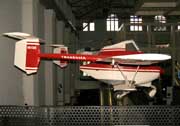 Deliveries were good for 110 aircraft. In December 1970 the prototype PL-12U was flown, and certified the following year. This was intended as a multi-role aircraft for cargo, passenger, air ambulance and aerial survey tasks. In Thailand it was even armed and used for counter-insurgency operations. In 1976, the T320 was released with the RR/Continental Tiara 6-320 engine, but when this engine was no longer available changed to the Lycoming IO-540-K1A5. This new version became the T300 Skyfarmer. Some of these have been assembled in New Zealand by Flight Engineering Ltd.
Deliveries were good for 110 aircraft. In December 1970 the prototype PL-12U was flown, and certified the following year. This was intended as a multi-role aircraft for cargo, passenger, air ambulance and aerial survey tasks. In Thailand it was even armed and used for counter-insurgency operations. In 1976, the T320 was released with the RR/Continental Tiara 6-320 engine, but when this engine was no longer available changed to the Lycoming IO-540-K1A5. This new version became the T300 Skyfarmer. Some of these have been assembled in New Zealand by Flight Engineering Ltd.The Airtruk is fully aerobatic with a limited load. A number of components such as the tailbooms, tail surfaces, ailerons, flaps, shock absorbers and wheel assemblies are interchangeable. A small cabin behind the hopper can hold 2 passengers for ferry flights. Source: www.kiwiaircraftimages.com/airtruk.html Peter Layne wrote me the following: " The Transavia Airtruk is actually an adaption of the New Zealand designed Bennetts Air Truck. That is why it is Truk and not Truck. Look at http://en.wikipedia.org/wiki/Aerial_topdressing and scroll down to "War Surplus". I have been towed in gliders by an Air Truk and it did the job very well. Seems strange looking between two tails than the usual one! " |
 Amazing to see this flying boat suspended from the ceiling! It is a Consolidated Catalina PB2B-2 ("Frigate bird II") with registration VH-ASA and c/n 61154.
Amazing to see this flying boat suspended from the ceiling! It is a Consolidated Catalina PB2B-2 ("Frigate bird II") with registration VH-ASA and c/n 61154. It was manufactured by Boeing Aircraft of Canada Limited of Vancouver,Canada in 1944. It was flown on a pioneering flight Australia-Chile, by P G Taylor in 1951. The PBY Catalina was the most successful flying boat ever produced. First flown in March 1935, they were in production for over ten years and were designed and built by the American aircraft manufacturers, Consolidated Aircraft of San Diego, California. The Museum's Catalina is one of 168 ordered by the RAAF, No. A24-385, for service during World War II. It was built under licence from the Boeing Aircraft of Canada Limited, Vancouver, in 1944, as a type PB2B-2 and arrived in Australia on 3 September 1945, only weeks after the Japanese surrender. 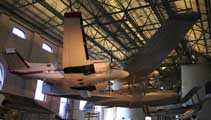 The PBY was the first US aircraft to carry radar and fulfilled diverse missions including torpedo-bomber and transport. Famous were the Black Cat Catalinas which, painted matt black, roamed the western Pacific from December 1942 finding Japanese ships by radar at night and picking Allied survivors from ships and aircraft in boats and dinghies.
The PBY was the first US aircraft to carry radar and fulfilled diverse missions including torpedo-bomber and transport. Famous were the Black Cat Catalinas which, painted matt black, roamed the western Pacific from December 1942 finding Japanese ships by radar at night and picking Allied survivors from ships and aircraft in boats and dinghies. The flight to South America, which left the Rose Bay flying boat base on 13 March 1951, had the smallest workable crew comprising, Captain G H 'Harry' Purvis (first officer), L 'Blue' L'Huillier (engineer), Angus Allison (radio officer and bowman) and Sydney Morning Herald journalist, Jack Percival (executive officer and official correspondent). Eight fuel stops were made, the last being at Easter Island. The fact that there was no sheltered area of water for take-off here was a serious hazard. It suffered through a storm, freak swell, broke all three of its anchor ropes and Taylor was washed overboard. Finally take-off was executed with the assistance of the JATO rockets (Jet Assisted Take-Off) on the hull fitted especially by the RAAF. After 8,451 miles (13,600 km) the flight was a success and a proud Commonwealth Government presented Frigate bird II to Taylor in recognition of his aviation achievements. In 1961 Taylor presented the Catalina to the Museum and in 1985 it was restored structurally and cosmetically by Hawker Pacific at Bankstown Airport. Read more... |
UPDATE SEP.2024 ON FACEBOOK / HISTORIC AUSTRALIAN AIRCRAFT  |

LAWRENCE HARGRAVE (1850-1915) He was an Australian aviation pioneer, inventor, explorer, mason and astronomer. "If there be one man, more than another, who deserves to succeed in flying through the air, that man is Mr. Laurence Hargrave, of Sydney, New South Wales. He has now constructed with his own hands no less than 18 flying machines of increasing size, all of which fly, and as a result of his many experiments (of which ,an account is about to be given) he now says, in a private letter to the writer, that: "I know that success is dead sure to come." (Octave Chanute, 1893) Lawrence Hargrave was born in Greenwich England on 29Jan1850 and educated in England. In 1872 he came to Australia in search of gold, but the ship chartered by the group of adventurers was wrecked off the Queensland coast. In June 1877 he was elected a member of the Royal Society of New South Wales. In 1878 he was appointed an assistant astronomical observer at Sydney Observatory, a post which he held until 1883, when he retired to devote the remainder of his life to research work into problems connected with human flight. This statue is located at Stanwell Park, Sydney; perhaps it played a role in his career as we witnessed parasailers jump off the bluff here under excellent conditions for them. I was told the Bros. Wright benefitted from Hargrave's research and experience. Read more... |
|
My visit to Historical Aircraft Restoration Society (HARS) at Illawarra Regional Airport a.k.a. Albion Park (near Wollongong,NSW) was on a Sunday, by appointment; due to my overloaded itinerary I could not arrange this in any other way. Unfortunately this coincided with the Airbus A380 first visit to Australia and its appearance during celebrations of QANTAS 85th anniversary; the HARS was actively taking part in these celebrations, ignoring (kidding!) my first ever visit to these parts of the world... But not quite as hopeless as that. A few phonecalls amidst the preparations gave me directions of the people to contact to gain access to the ramp; thanks Mark! I may have appeared a bit lost, as someone (who was showing other people around) took care of me and gave me the tour! All down to luck and the Australian "No Worries, Can Do"! Thanks John! |
 Eight aircraft survive today, however only 3 are known to be airworthy (all Mk.2s): VH-ADN c/n 5009, VH-AZS c/n 5018 and VH-DHM c/n 5020. VH-DHM is fully serviceable and is currently on a long-term lease to the HARS from Hawker De Havilland. Read more... |
VH-DHM, De Havilland Australia DHA-3 Drover Mk II, c/n 5020
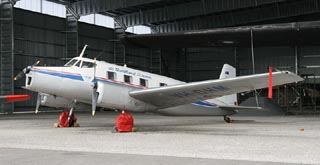 The Drover was designed and built in the late 1940s by De Havilland at Bankstown,NSW. Only 20 of this type were built with the first having its maiden flight in 1948. Operators of this type were Qantas and TAA as passenger and cargo aircraft; another operator was the Department of Health. But their most renowned role was with the Royal Flying Doctor Service, serving as an air ambulance well into the 1960s. |
|
An issue of Air-Britain's Aviation World (Autumn 2006) contained an extensive article on the DHC-3 Drover, written by Derek King. It also contained a comprehensive table of specifications, which I hereby reproduce- |
| Wing Span | 57ft 0in - 17.38cm |
| Length | 36ft 2in - 11m |
| Height | 9ft 9in - 3m | Empty Weight | 4,100lb - 1,859kg |
| Take of Gross Weight | 5.600lb - 2.950kg |
| Max Fuel | 90 gal - 408 ltr |
| Engines | 3x 145hp DH Gipsy Major Mk.10 four cylinder inverted in-line engines driving de Havilland PD.80/2 MI/1 two-bladed fixed-pitch propellors |
| Max Speed | 140 mph - 225 km/h |
| Cruising Speed | 125 mph - 210 km/h |
| Max Range | 500 miles - 805 km |
| Take-ff Distance | 1.560ft - 475m |
| Landing Distance | 1.500ft - 460m |
| Accommodation | One crew and 6-8 passengers |
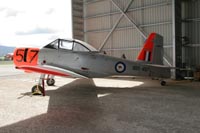 All the aircraft here are airworthy, the museum is not interested in aircraft which cannot be made flyable.
All the aircraft here are airworthy, the museum is not interested in aircraft which cannot be made flyable.This CAC Winjeel, marked "A85-457" is VH-HFE. |
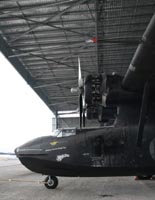
|
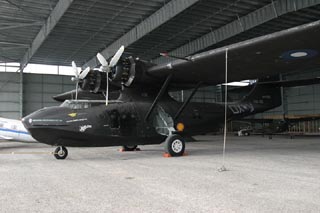
|
| Update from Nov.2010 issue of The Catalina Society / World Catalina News- "Work has continued on the airworthy PBY-6A VH-PBZ operated by HARS (Historical Aircraft Restoration Society). In addition to the recent installation of a fine pair of hull blisters and a bombardier's window in the extreme bow, a bow turret has now been put in place too and the end result looks really good! The nose support structure was donated to HARS by the Pima Air and Space Museum, Tucson, Arizona whilst a new "unused" turret was acquired from Canada with the assistance of the Morabbin Aviation Museum, Melbourne. A new gloss RAAF Black Cat paint job has given the Catalina the finishing touches although the overall scheme representing the 42 Squadron, RAAF aircraft A24-362/OX-V remains the same with the Felix the Cat motif still in place on the forward hull." |
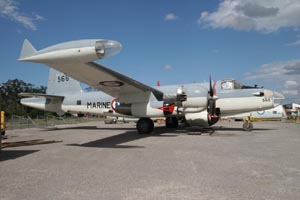 Neptune 566 was one of 26 operated by the French armed forces from 15Apr69 and was allocated to French Marine Escadrille 12 Squadron. The aircraft (147566 c/n 7183) was eventually based on the French Polynesian territorial island of Tahiti in the Pacific and was operated on patrol duties during the early 1980s in connection with the French nuclear test program on Muroroa Atoll. It was retired from French marine service in 1984 and stored at Papeete International Airport, Tahiti.
Neptune 566 was one of 26 operated by the French armed forces from 15Apr69 and was allocated to French Marine Escadrille 12 Squadron. The aircraft (147566 c/n 7183) was eventually based on the French Polynesian territorial island of Tahiti in the Pacific and was operated on patrol duties during the early 1980s in connection with the French nuclear test program on Muroroa Atoll. It was retired from French marine service in 1984 and stored at Papeete International Airport, Tahiti. In July 1989 it made the long trip from from Tahiti to Australia; During its French maritime career it had flown a total of 2,430 hours and by the time of the purchase by HARS it was considered to be in excellent condition (it had been extensively overhauled just prior to being de-commissioned in 1983). Neptune 566 was placed on the Australian civil register as VH-LRR, and, after a number of public appearances at air shows, was positioned to Tamworth for storage and care. In September 1999 the aircraft was ferried from Tamworth to Bankstown for the purpose of undergoing an extensive overhaul programme by the Society. VH-LRR was flown to the new HARS base at the Illawarra Regional Airport, Albion Park in January 2003 where the overhaul work continues pending return to full flying status. Source http://hars.org.au/ |
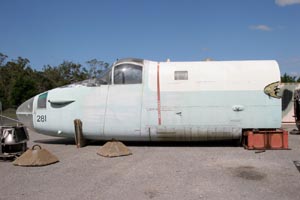
|
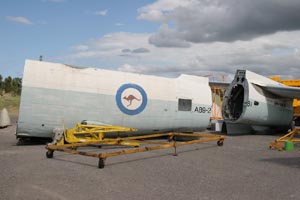
|
|
The remains of Lockheed SP-2H Neptune A89-281.... Its construction number is 726-7281 (BuNo 149081); it was decommissioned on 06Dec77 and flown from Townsville to Amberley for disposal; this was also the last flight undertaken by a Neptune aircraft of the RAAF. In 1978 281 was sold to Chewing Gum Field Museum, Tallebudgera, QLD and trucked to the museum. During 1989 it was again sold, to Alan Wilson and donated to the Australian Flying Museum; on 12Jul90 it was trucked to Archerfield Airport-Brisbane. During 1992 tailnumber VH-NEP was reserved and painted on the aircraft. In July 2000 AeroCorp Australia Pty Ltd of Perth bought it and it was to be trucked from Archerfield to Perth for conversion to fire bomber... but this was not to be. In Aug03 it was donated to HARS by AeroCorp; subsequently work began on dismantling the aircraft for trucking to Parkes,NSW. Source: The Lockheed Files Allen Clarke wrote me in Jan.2006: "the Neptune at Albion Park marked VH-NEP should not be referred to as such as it was n.t.u. I still refer to it as A89-281. The real NEP resides in Western Australia and is c/n 7191." Thanks Allen ! |
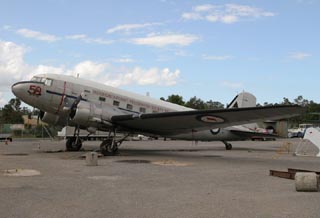
|
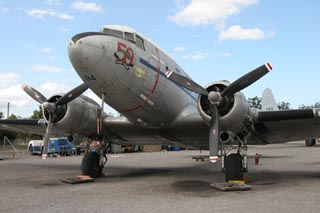
|
|
A65-95 was built in Oklahoma City as a C-47B-30-DK with c/n 16348 but due duplicating errors corrected to c/n 33096; it was delivered to the USAF on the 20Apr1945, registered as 44-76764. This C-47B was then delivered to No.38 Sqdn RAAF at Archerfield Base on the 08May45 as A65-95 ("VH-RFL"). It had a long career with the RAAF and served with several units and on various tasks. A65-95 was transferred to No.37 Sqdn on 10Oct46 where she had her wartime camouflage removed and was employed on courier flights to Japan in support of the British Commonwealth Occupation Forces. She flew shortly with 86 Wing at Richmond (No.36 Sqdn and 1 Communication Unit) and was transferred to the Central Flying School at East Sale. There she was flown in support of the RAAF School of Radio Ballarat and training of GCA operators as well as aircrew training and general transport support tasks. A65-95 was transferred to the Aircraft Research and Development Unit (ARDU) at Laverton Victoria on 14Mar61 and stayed with that unit when it moved to Edinburgh SA in Feb77. While at ARDU, A65-95 was engaged primarily on the calibration of radio navigation aids, although there were many occasions when she was used to transport University Air Cadets to camps at Edinburgh, Amberley, Wagga and Fairbairn. Other tasks whilst on duty were: RAAF Signaller training, search and rescue, aerial photography and trials support. 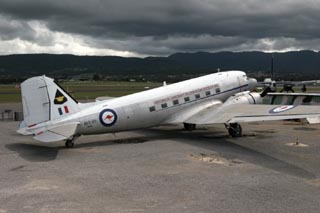 A65-95 served in ARDU until 1997 and was decommissioned in 2000. At this time she had flown a total of 14,900 hours and was 55 years old.
A65-95 served in ARDU until 1997 and was decommissioned in 2000. At this time she had flown a total of 14,900 hours and was 55 years old.She was acquired by HARS in July 2000 and had been the victim of spare parts requirements for a few years. As a result she required many parts to get her back in the air again. This was achieved by begging, borrowing and stealing parts until she was ready to fly again. She was then flown from Edinburgh in Adelaide to Bankstown in Sydney, where she went through restoration and registration onto the domestic register as VH-EAE. It took a further 2 years to replace the borrowed parts and complete the 100 hourly service and become airworthy again. Thanks to the RAAF the aircraft was essentially left in RAAF livery. The only changes to the livery were that the words “Royal Australian Air Force” on both sides of the fuselage were changed to “Historical Aircraft Restoration Society” and the ARDU insignias on the tail were changed to the HARS insignias. Source: http://hars.org.au/ |
 Pride of the fleet: Lockheed C-121C Super Constellation VH-EAG (c/n 4176).
Pride of the fleet: Lockheed C-121C Super Constellation VH-EAG (c/n 4176).VH-EAG "Southern Preservation" (but commonly referred to as "Connie") was originally built as a C-121C for the United States Air Force, serial number 54-0157, c/n 4176, and was delivered on the 6Oct55 when it was allocated to the 1608th Military Air Transport Wing based at Charleston,SC. On the 25Jul 1962 it was transferred to the Mississippi Air National Guard and on the 14Feb67 it moved on to West Virginia Air National Guard, where it served for the next 5 years. Connie's last active duty was with the Pennsylvania Air National Guard from mid-1972 until its storage at Davis Monthan AFB at Tucson, AZ in Jun77. Considered obsolete and of no further use, storage maintenance ceased in 1981 and as a result was designated of scrap value only. In addition most of the engine accessories and instruments had been cannibalised. Failure to re-seal the aircraft after an inspection permitted access to legions of birds to nest and foul the interior over many years. This in turn discouraged the scrap metal merchants from bidding on the aircraft due to the infestation of guano and the subsequent imperfections that it would cause in the smelting of the aluminium... 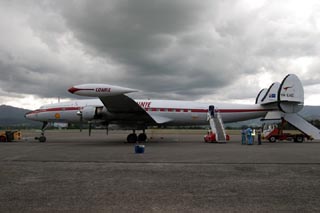 54-0157 was purchased by HARS in Nov91 for restoration and delivery to Australia. The restoration work started in May92 at Pima Air & Space Museum and in Sep94 the Super Constellation took to the air after nearly 18 years on the ground. In late 1995 final flight training was undertaken. On the 03Feb96 VH-EAG arrived in Sydney after an incident free crossing of 39.5 hours flying time!
54-0157 was purchased by HARS in Nov91 for restoration and delivery to Australia. The restoration work started in May92 at Pima Air & Space Museum and in Sep94 the Super Constellation took to the air after nearly 18 years on the ground. In late 1995 final flight training was undertaken. On the 03Feb96 VH-EAG arrived in Sydney after an incident free crossing of 39.5 hours flying time! The major difficulty in the restoration process was the need for the volunteers to continually travel to Tucson to carry out the restoration work: time consuming and costly. (The tiptanks may be cosmetic and not actually "plumbed" for use.) Source and more: http://hars.org.au/ David Carter wrote also the following about the engines: "..the engines on 'EAG are R-3350-93s. C-121s were built with R-3350-91s. In the Wright numbering methodology, the -93 would be a minor derivative of a -91. Google the web and -93s are linked with C-121s, so it looks like there was some minor upgrade during the service life of these planes..." |

|

|
|
I had arrived when the aircraft was being prepared for a flight the next day; QANTAS was celebrating its 85th anniversary (nov.16th) and things wouldn't be complete without the Super Connie of the HARS; I could not find accommodation to spend the night (1 motel, fully booked) and had a schedule to adhere too; pity as it would have been great to witness VH-EAG taking off. Another disadvantage for visiting on a Sunday: the HARS souvenir shop was closed so I had to leave without a souvernir t-shirt... I should remedy that on a next visit! |

|

|
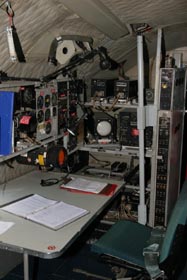
|

|

|

|
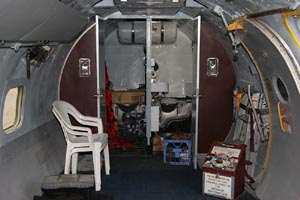
|
|
Slightly south of Albion Park (well, the term "slightly" in way of distances in Australia should not be taken literally) is Nowra and Australia's Museum of Flight is located next to the air base here; in fact, the museum's verandah overlooks the historic airfield at HMAS Albatross which has variously served the RAAF, the USAAC, the British Navy, the RNZAF and the RAN for more than half a century. The museum has an interesting collection and I'll start with this Douglas DC-3. This Douglas C-47A (c/n 12542) was initially serialled 42-92711 for the USAAF but transferred to Australia for the RAAF as A65-43 (19Mar43); it served with No.33 Sqdn from 19Mar44 to Mar46; it changed to the Royal Australian Navy (RAN) on 01Feb49 and its tailnumber was revised to N2-43 (the aircraft was "reconditioned" before delivery to RAN, whatever that means). Source: www.adf-serials.com/2a65.shtml |

|
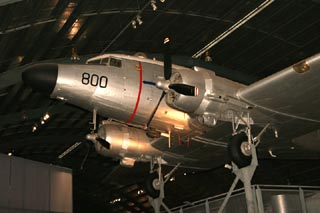
|
|
Its service with the RAN continued for a long time; at one time it had a peculiar nose section fitted to train Navy navigators/radar operators: it housed a DeHavilland Sea Venom radar unit. N2-43 also featured a retractable 'dustbin' radar of a Fairey Gannett (fited under the fuselage). During Oct74 it was operating or transferred to No.851 Sqdn. It was donated to the museum at HMAS Albatross, Nowra in 1976. |

|

|
 The owner of this Lockheed L-10A Electra VH-UZO (c/n 1107) is Laurie Ogle (Vintage Electra P/L).
The history of this fine looking aeroplane reads thus:
The owner of this Lockheed L-10A Electra VH-UZO (c/n 1107) is Laurie Ogle (Vintage Electra P/L).
The history of this fine looking aeroplane reads thus:On 04Jul37 it ranof the production line with Lockheed's Burbank plant; it was produced as an L-10B with Wright Whirlwind engines. It arrived by boat on 09Aug37 at Victoria Dock, Melbourne for to Ansett Airways. It entered the Australian Register as VH-UZO on 26Aug37. During March 1942 VH-UZO participated in the evacuation of Broome,WA and Darwin,NT after Japanese air raids and as from Jun42 it was leased to the USAAF for 3 years. Operated mainly Melbourne-Cairns and Melbourne-Darwin averaging 20 hours daily.
Its career was no bed of roses:
|

|

|

|

|

|

|

|

|

|

|

|

|

|

|

|

|

|

|

|

|

|

|

|

|

|
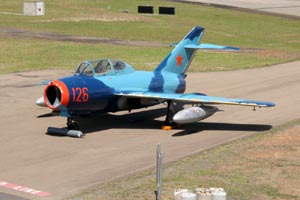 This MiG-15 I don't really know much about...
This MiG-15 I don't really know much about...I was told it doesn't belong to the museum; it had attended an air show here but due bad weather was left behind by the owner until it could be ferried to its home base (Temora?) in better weather circumstances. Mark wrote me in jan.2006: "I have some more information on the Mig 15 which you saw at Nowra. It is one of two owned by a company called Air Combat Australia and is used for experience flights. The registration is VH-EKI. You can find details of the company and its aircraft here :- http://aircombat.com.au/" |
|
32883 is almost a twin ! "Born" as 44-76551 while delivered on 29Mar45, it was transferred as A65-90 to the RAAF (VHRFG) and assigned to No.35 Sqdn on 06Apr45. Here is a gap too, in its history: on 14Feb68 we see it assigned to the Royal Australian Navy as N2-90 (VMNSK). In 1968 it served No.851 Sqdn. An end to its active career came in Apr74, though it served in some capacity the Apprentice Training Establishment at Schofields, NSW. At some point it joined the Navy Historical Flight (as N2-90/VH-NVZ). In Nov.2006 James Bailey wrote me:
Bob Wood wrote me in May 2007: Read my post on Photos by Friends & Guests #61 (july 2020) for an update on N2-90: |
 15Nov05 saw us visiting the War Memorial in Canberra, a truly fantastic museum displaying all the wars Australia had been involved in; and there were more than I had expected.
15Nov05 saw us visiting the War Memorial in Canberra, a truly fantastic museum displaying all the wars Australia had been involved in; and there were more than I had expected.A link and description can be found on my travel account A few aircraft are on display too; this display is called "G for George" and shows a W.W.2 Avro Lancaster. The thumbnails below show the rest of the aircraft on display; click on them for a larger image. |

|

|

|

|

|

|

|

|

|

|
 Being Dutch, and an aviation enthusiast, I felt obliged to visit Albury!
Being Dutch, and an aviation enthusiast, I felt obliged to visit Albury!A Melbourne businessman, Sir Macpherson Robertson, sponsored London to Melbourne Air Race in 1934. There was a category for speed and a race by handicap (some planes were custom built for racing, while others had not). The distance was over an 11,300 mile course; 20 entrants took part; 11 finished the course; 3 aircraft crashed; in 1 case killing both crew. The Dutch connection here is that a Douglas DC-2 from KLM Royal Dutch Airlines won the handicap race; they finished second place in total. But it had almost ended here for the DC-2: the crew became lost in severe thunder storms in the final leg of the journey. Towards midnight on October 23rd 'the Uiver' began circling seeking bearings. Corowa radio station 2CO broadcasted appealed to motorists to assemble at Albury Racecourse to light the fields with their headlights. The plane made a perfect landing in torrential rain on the 200 yard "runway". The next morning 300 spectators gathered to pull out the now bogged plane by ropes so that the plane could continue the race, jettisoning everything to lift off. It was Albury at its most heroic. The aircraft here is in fact Douglas DC-2-112 A30-11 (VH-CRE, c/n 1286); it was used for training wireless operators/airgunners and as a freighter. The DC-2 was decommissioned in 1946 and purchased by Marshall Airways of Mascot,NSW. In 1979 it was purchased by the Albury West Rotary Club as a dismantled wreck and restored as the "new Uiver" for display at Albury Airport. It has suffered through the years by neglect, but I was told that it will be overhauled (no date as yet) for display in the new terminal, which will be extended to double its present size to accommodate the increasing numbers of passengers travelling to/from Albury,NSW.
There is another photo on my travel account. |
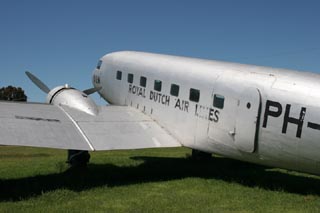
|
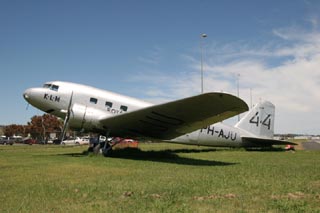
|

|

|

|

|

|

|

|

|

|

|

|

|

|

|
|
Bob Ingraham quoted the following text from the London Times about the fatal crash of PH-AJU: "THE HAGUE, Dec. 21, 1934 The Douglas airliner of the K.L.M. Line, which was on her way to Batavia with special Christmas mail, and was yesterday reported to be missing after leaving Cairo, crashed in the Syrian desert. All on board – three passengers and a crew of four – have lost their lives. The burned wreckage of the machine was found near Rutba by Royal Air Force aeroplanes of No. 14 Squadron from Amman, and news of the disaster was received in Holland at 10 o'clock this morning from the Royal Air Force headquarters...." |
In August 2006 Roger MacDonald kindly brought me up to speed by sending an article. The article Roger forwarded dated from Aug.2nd 2006 and was written by Brad Worrall for www.bordermail.com.au local news (dead link) -
In 2007 the project of restoring this DC-2 went on hold... David Carter sent an update in June 2008 with developments on 'the Uiver':
UPDATE July 2024:  An 89-year-old Douglas DC-2 airliner has arrived at Australia’s Historical Aircraft Restoration Society (HARS) Aviation Museum for restoration. Built-in May 1935 at Douglas’ Santa Monica plant, this historic aircraft will be restored and displayed at the museum at Shellharbour Airport in NSW, although it is not expected to fly again. HARS highlights the plane’s “fascinating history,” which aligns with its mission to preserve Australia’s aviation heritage. Despite being overshadowed by the later DC-3 and its military versions (C-47/Dakota), of which over 16,000 were built, the pioneering DC-2 changed passenger aviation history with 156 constructed. Originally operated by Dutch airlines in the East Indies, the DC-2 was evacuated to Australia from Batavia ahead of enemy invasion in 1942. It was then taken over by the US Army Air Force under General MacArthur’s orders and was badly damaged in Port Moresby by an enemy bombing raid in 1942. After WWII, it was reconfigured to seat 17 passengers for ANA in Melbourne, then sold to Sid Marshall at Bankstown Airport to operate weekend joy flights over Sydney under the registration VH-CDZ. Damaged in 1957 and struck off the register, it was owned by several parties with successive restoration or dismantling for parts plans. |
 Wangaratta is a town in Victoria about 45 mins from Albury. Whilst under the impression there was a disused air museum (Wangaratta Air World Museum, the collection featured some very historic Pacific World War II aircraft) here, I stumbled into an aviation factory, producing World War II planes !
Wangaratta is a town in Victoria about 45 mins from Albury. Whilst under the impression there was a disused air museum (Wangaratta Air World Museum, the collection featured some very historic Pacific World War II aircraft) here, I stumbled into an aviation factory, producing World War II planes !What an impressive set up. They have here World War 2 planes either being rebuilt or produced as new from the original specifications or by salvaged (damaged) parts. After the museum closed in 2002, many of its planes were sold or relocated. Now, the Air World facility has become home to Precision Aerospace's Pacific Fighters Museum, which is currently restoring a number of historic WWII Pacific aircraft. ) And while we arrived unannounced, we were kindly shown around and received quite a bewildering amount of information. Douglas C-47 43-48234 is listed on the website to reside here, but it has moved up north to Cairns; see my page part 1, Cairns to Sydney. |
| Hover over the thumbnails to read the labels for information, click on them for larger images; updates welcomed. |

|

|

|

|

|

|
| Info on P-40 2105915 |
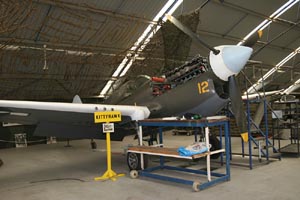
|

|
|
|

|

|

|
|

|

|

|

|

|

|

|

|

|

|

|

|

|

|

|

|
Douglas A-20 Havoc 43-9436 A-20 Havoc on Wikipedia |

|
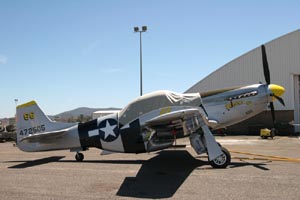 472505 on www.mustangsmustangs.net |
|
On 17Nov05 I was heading out for the 2 airports of Melbourne: Tullamarine ("Tulla") and Essendon; the latter is the former international airport but is no shade of its former self, looked rather decrepit I would say. Gordon Reid wrote in defense: "I am sorry that you found Essendon looking a bit rundown, however remember that in 2005 the airport celebrated its 85th birthday ! Since being privatised a few years ago a lot of changes have taken place and it seems you arrived in the middle of a busy reconstruction phase. Essendon was homebase to great airlines such as ANA, Ansett Airways, Ansett/ANA and Trans Australia Airlines and its hangars, buildings and terminal still bear testament to these companies.".
For various reasons I had found little time to research the Douglas DC-3s here and I did not have a clue where to look for them. At first I drove around at Tullamarine: General Aviation and Maintenance areas are always a good place to look for them. I asked around but initially without result. Then, as luck would have it, I met John Booth, who was able to arrange something if I could return after lunch; and he did, great guy! He cleared it with security, arranged a pass, found me a rampvest and there we I was: next to 'the Hawdon'! |
|
My luck held that day... John advised me to have another look at the Ansett hangars as that day news became public Ozjet received its operating permit and one of their Boeing 737s could be out to be seen; well, I did not get to see the Ozjet 737, but I was right on time to see VH-ABR taken out of the hangar for a test run on both engines! I had to cope with 2 fences and stored jet aircraft parked in front of me, but it was a spectacle to enjoy nevertheless! VH-ABR is the only DC-3 in Australia with Wright Cyclone engines, instead of the P&W R1830 engines.
|
|
Essendon made a dilapidated impression on me, which fortunately cannot be said of the DC-3s operating here! VH-OVM (cn16354/33102) is a C-47B and seems in excellent condition; it is operated by Shortstop Jet Charter on scenic flights and charters; the titles on the fuselage read "Melbourne's Gooney Bird". It would be great to join for a flight one day. |
 This C-47B started as 44-76770 upon delivery 21Apr45; it was soon transferred to the RAAF as A65-98 ("VHRFO") on 07May45. There is an unrecorded gap in its history, but we pick it up whilst with TSF Butterworth A65-98/VMHJZ from 1964 to 1973 and from 1980 to 1982 at Wagga Wagga for Apprentice Training.
This C-47B started as 44-76770 upon delivery 21Apr45; it was soon transferred to the RAAF as A65-98 ("VHRFO") on 07May45. There is an unrecorded gap in its history, but we pick it up whilst with TSF Butterworth A65-98/VMHJZ from 1964 to 1973 and from 1980 to 1982 at Wagga Wagga for Apprentice Training.It left Wagga Wagga for Point Cook. It entered the civil register as VH-JXD on 03Jul89 (for whom?), which was replaced by VH-OVM (date?). On 20Jul90 it was registered for Shortstop Jet Charter. The Australian Civil Air Register shows VH-OVM as registered to Shortstop Jet Charter Pty.Ltd. 20Dec05 (again?); the register also records "Aircraft first registered in Australia: 20 June 1990", so maybe VH-JXD in 1989 was never officially recorded. The photo below,right shows titles: www.shortstop.com.au, be sure to have the sound of your PC turned on! Greg Lamey wrote me in Feb.2006: In reference to VH-OVM at Essendon, I flew in this aircraft last year and it is owned and operated by Mike Falls Senior / Shortstop Jet Charter, not DC3 Australian Air Holidays... |
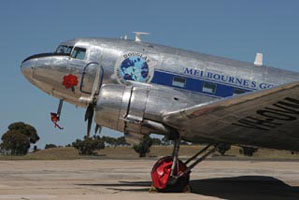
|
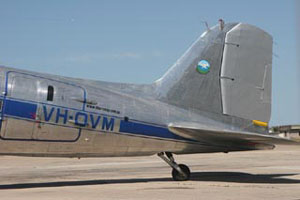
|
|
On 18Nov05 we visited the Australian National Aviation Museum, a.k.a. Moorabbin Air Museum. I think I was lucky to find the museum open as it has limited opening hours: Wednesday, Thursday, Friday 12:00 to 16:00 and Saturday and Sunday 10:00 to 17:00. |

|
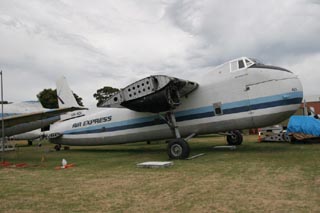
|
|
VH-ADL "Tasmanian Devil" is a Bristol 170 Freighter, quite a unique aircraft! David Carter shared some good memories on the "Biffo".. |
|
C/n 4120 is a pre-war Douglas DC-3-277D, built for American Airlines (destined to become NC33657), but drafted for the war effort; so reconfigured as a
DC-3-396/C-50 it joined the USAAF as 41-7698 upon its delivery on 31Jul41. It was assigned to the 5th Air Force in Australia on 17Sep42 and found its way to the RAAF as "VHCDJ" with No.36 Sqdn (named "Waltzing Matilda"' and also "Winnie") in June 1943. |
|
It was assigned again to the USAAF on 28Apr44, but not for long as on 16May44 it was registered as VH-CDJ for Guinea Airways, becoming VH-ANH on
12May46. But again ownership quickly changed: it joined Australian National Airlines (named "Tullana"; ANA was formed by a merger in 1936 of various airlines, including West Australian Airways, Adelaide A/w, Holymans A/w and shipping interests) on 01Jul46. Ansett and ANA merged in Oct57 to become Ansett-ANA. Airlines of South Australia became the operator in 1961 of VH-ANH. Victoria Air Coach was next (date?), but this may have been a lease for in 1963 Ansett-ANA was registered owner/operator again. And back again to Airlines of NSW in Oct66 until its decommissioning on 24Dec70. |
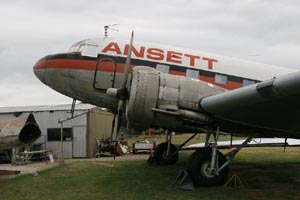
|
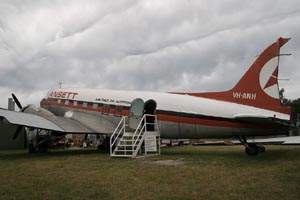
|
 Consolidated PBY Catalina A24-88 has some way to go for restoration!
Consolidated PBY Catalina A24-88 has some way to go for restoration!It was recovered from a farm in southern New South Wales and donated to the museum by Mark Anderson and a number of other members of the syndicate which had acquired it for a houseboat in the 1960s. This Catalina is a genuine WWII combat veteran flown by Sqn. Ldr. Fred Robey of No.42 Sqdn RAAF. Cleaning and preservation work includes the removal of concrete ballast from the hull; during these efforts .50, .45 and .30 calibre brass has been recovered from various nooks and crannies around the gun positions! Read more... |
| The Vickers Viscount was the first turboprop airliner to enter service anywhere in the world: the prototype flew on 16Jul48. Certification was achieved on 17Apr53, and it entered service with BEA the next day. Whilst Australian National Airlines intended to stick with piston engined aircraft such as the DC-6, TAA (Trans-Australia Airlines) ordered six Viscounts, the first arriving in October 1954 - registered as VH-TAA and named John Batman. Planned commencement of service on December 1 was deferred when the aircraft crashed on a training flight, killing three of the five people on board, on 30th October 1954. |

|
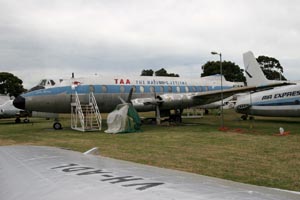
|
|
TAA fitted a Viscount with slipper fuel tanks to equip it for the long flights such as Melbourne-Adelaide-Perth. Following this competitive move, TAA ordered more Viscounts, and ANA tentatively ordered more DC-6Bs. Ansett applied to purchase a further Convair 340. By 1957, TAA's Viscount fleet numbered twelve, including three with the additional fuel tanks and two with the Mk. 506 Dart engines which added 30 kts. (56 km./hr.) to their speed. Butler Air Transport also ordered Viscounts, and found the runways which had served their DC-3 fleet were too short for the new aircraft. They broke into the Melbourne-Sydney route with Viscount VH-BAT "Warral" on 12Dec55. The Dept of Civil Aviation, meanwhile, declared several provincial airports unsuitable for Viscount operations. Butler acquired three Airspeed Ambassadors in 1957 to continue their services to these airports (which their DC-3s could no longer handle). |
|
Pride of the the collection is the Bristol Beaufighter. Neil Follett wrote me in Jan.2006: "the serial number of the Beaufighter on display is actually A8-328. The serial painted on it was done so a few years ago because an ex-31 squadron Beaufighter pilot donated a sum of money towards its restoration if it was painted in the markings of one he used to fly. Page 86 of the latest “AERO” magazine it shows a photo of the aircraft as we found it at Portsea in 1962. I was one of the original members back in 1962 when the Australian Aircraft Restoration Group was formed specifically to obtain the Beaufighter from a children’s camp at Portsea. The aircraft was to be sold for scrap as the children had damaged it to the stage where it was becoming dangerous. " Thanks Neil ! |

|

|

|

|

|

|

|

|

|

|

|

|

|

|

|

|

|

|

|

|

|

|
|

|

|
|
The museum is running out of space, both outside as well as inside. Douglas DC-2-112 (c/n 1292, A30-9 "VH-CRK"), purchased during 2005, was nowhere in sight yet. But John McCulloch wrote me in July 2006 portions of it (including one outer wing, tailplane and engines) had arrived and the rest was imminent. John wrote this "Most of the DC-2 arrived at Moorabbin last Sunday morning (31Jul06). We are now missing only one outer wing. The initial conservation efforts will involve fitting new perspex to the cockpit and window areas, patching some of the more badly corroded panels, and fitting a temporary floor to facilitate easier movement within the fuselage. We have two engines and a spare, and perhaps even a further pair of engines which may be donated from interstate. One of members dug up a letter from Air Pictorial of March 1970 where the correspondent noted that the wing from our DC-2 had been fitted to the DC-1 to enable it to be flown from Miami to Los Angeles, presumably after suffering damage. This fact was brought to light when the DC-1 was unloaded in England, and one wing carried the registration NC13782." |
|
This concludes my aviation account of this trip. Thanks to the "Oz-spotters", esspecially Terry and Clive. Thanks to Ron Cuskelly and Neil Follett for their corrections and updates. John Booth, thanks for opening doors for me. And the way this trip went, a very special thanks to my wife Ada for her patience and allowing me to pursue my maniac targets... |
Helpful links:
Australian Military Aircraft Serials and Aircraft History
Warbirds Down Under
Warbird Registry
Spirits of Ansett
Australian Civil Aircraft Register
Plane Spotting in Australia
![]()
|
|
Last updated 09.aug.2009